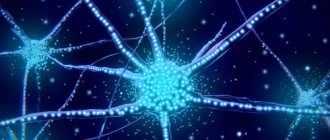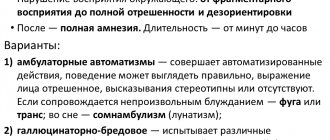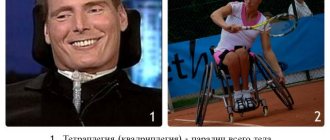Treatment should always seek the causes of the disease through logic, understanding and “respect” of structures - Leopold Busquet.
In recent years, the number of children with attention and memory deficiencies, increased distractibility and mental fatigue, and speech defects has increased sharply. Many of these children exhibit disorders of social adaptation, impaired writing and reading, various dysfunctions of the gastrointestinal tract, and postural defects. This is evidenced by the work practice of child neurologists, educators and teachers of preschool institutions and primary schools.
Causes of disease development
- Somatic diseases of the mother with symptoms of chronic intoxication.
- Acute infectious diseases or exacerbation of chronic foci of infection in the mother’s body during pregnancy
- Malnutrition and general immaturity of women
- Hereditary diseases and metabolic disorders
- Pathological course of pregnancy (early and late toxicosis, threat of miscarriage, etc.)
- Harmful environmental influences, unfavorable environmental conditions (ionizing radiation, toxic effects, including the use of various medications, alcohol, drugs, smoking; environmental pollution with heavy metal salts, etc.)
- Pathological course of labor (rapid labor, weakness of labor, etc.) and injuries when using birth aid.
- Prematurity and immaturity of the fetus with various disorders of its vital functions in the first days of life.
It is necessary to pay attention to the fact that in the first trimester of intrauterine life, all the main elements of the nervous system of the unborn child are formed, and the formation of the placental barrier begins only in the third month of pregnancy.
The causative agents of infectious diseases such as toxoplasmosis, chlamydia, listerellosis, syphilis, serum hepatitis, cytomegaly, etc., having penetrated the immature placenta from the mother’s body, deeply damage the internal organs of the fetus, including the developing nervous system of the child.
These damages to the fetus at this stage of its development are generalized, but the central nervous system is primarily affected. Subsequently, when the placenta has already formed and the placental barrier is quite effective, exposure to unfavorable factors no longer leads to the formation of fetal malformations, but can cause premature birth, functional immaturity of the child and intrauterine malnutrition.
It should be noted that the first six points of the eight causes of the disease listed above relate specifically to the period of conception and gestation, where the main role is played by the expectant mother.
The main consequences of perinatal damage to the central nervous system
- Full recovery.
- Delayed mental, motor or speech development.
- Minimal brain dysfunction (hyperactivity or attention deficit disorder)
- Neurotic reactions.
- Cerebrasthenic syndrome.
- Autonomic-visceral dysfunction syndrome.
- Epilepsy.
- Hydrocephalus.
- Cerebral palsy.
Children with the consequences of perinatal brain damage and left unattended by their parents at an older age often experience various behavioral disorders, neurotic manifestations, hyperactivity syndrome, disorders of autonomic-visceral functions, asthenic syndrome, frequent school maladjustment, etc.
It should be noted that with timely diagnosis in early childhood, existing disorders of the nervous system in the vast majority of cases can be almost completely eliminated by corrective measures, and children can subsequently live a full life.
With the start of school, the process of maladaptation with manifestations of disorders of the higher functions of the brain, somatic and autonomic symptoms accompanying minimal brain dysfunction, increases like an avalanche.
Methods to combat this disease
So, as has already become clear, the treatment of the disease that has arisen usually involves several stages. In case of an acute illness, it is urgently necessary to completely eliminate the influence of factors leading to anoxia:
- The child requires sanitation of the respiratory tract.
- Removal of a foreign body.
- It is necessary to remove the patient from the area of exposure to carbon dioxide.
- Strangulation must be stopped.
- Preventing the effects of electric current.
At this stage, it is necessary to maintain normal blood circulation and oxygen supply; in some cases, artificial respiration devices are used. In this case, support is provided at a level that should not allow irreversible changes in the brain. If natural breathing is preserved, the child requires oxygen inhalation and transportation to the hospital. If breathing is ineffective, intubation will be required.
Diagnosis of perinatal lesions of the central nervous system
The diagnosis of perinatal brain damage can be made only on the basis of clinical data; data from various research methods are only of an auxiliary nature and are sometimes necessary not to make the diagnosis itself, but to clarify the nature and location of the lesion, assess the dynamics of the disease and the effectiveness of treatment.
Often, one child has several types of perinatal lesions of the central nervous system. In this regard, it is important to conduct a comprehensive examination of the child.
In recent years, there has been a significant improvement in the diagnostic capabilities of children's medical institutions. Additional research methods have appeared in the diagnosis of perinatal lesions of the central nervous system:
- Neurosonography (method of echoographic visualization of the brain of a newborn and a child up to 1 year old, while the fontanelle is open)
- Electroencephalography (a method for studying the functional activity of the brain, based on recording electrical potentials of the brain.)
- Ultrasound examination of cerebral vessels
- Echospondylography of the cervical spine
- Electroneuromyography (study of nerve signal conduction and muscle response)
- Computed tomography (CT)
- Magnetic resonance imaging (MRI)
- Biochemical blood tests
- Consultations with specialists (endocrinologist, orthopedist, speech therapist, psychologist, etc.)
It should be noted that there is no need to apply all additional diagnostic methods at once. The specific research methods for your child will be determined by a specialist from our center based on the neurological status at the time of examination.
Restoration of vital functions
The next stage involves the restoration of vital functions. Thus, it is necessary to restore blood circulation, breathing and normal heart function. Further therapy is aimed at restoring all previously lost functions. For these purposes, neurometabolites are prescribed along with nootropics, vascular drugs, neuroprotectors and antioxidants.
Symptomatic therapy is aimed at eliminating the main manifestation of the consequences of anoxia. In case of severe headache, analgesics are used, and against the background of epileptic seizures, anticonvulsants are required, and so on.
Clinical manifestations
Brain aneurysm symptoms
has the following: muscle weakness on one side of the face, speech disorder, double vision, photophobia, fainting, sensitivity disorder, pain in the eyeballs, indigestion and discomfort in the upper abdomen.
It is important to note that in the initial stages there may be no symptoms. Symptoms occur only when the size of the aneurysm increases or when it ruptures. Also important is the amount of blood loss during rupture and what brain structures are involved.
symptoms of brain aneurysm
Cerebral aneurysm - consequences after surgery
The consequences of the operation, as well as the natural course of the disease, very often is cerebral vasospasm, which leads to unsatisfactory treatment results - death or severe neurological deficit in the form of paresis and paralysis, aphasia, mental disorders (which is typical for aneurysms of the anterior communicating artery). Meningitis may be a complication of the operation itself, which is associated with the presence of blood - a rich nutrient medium in the subarachnoid space, in the basal cisterns, cerebral ischemia, and a rather long operation time.
Thus, the treatment of arterial aneurysms is a very urgent and difficult problem in neurosurgery, especially in the acute and acute periods of hemorrhage.
Author of the article: neurosurgeon Anton Viktorovich Vorobiev Frame around the text
Why choose us:
- we will offer the most optimal treatment method;
- we have extensive experience in treating major neurosurgical diseases;
- We have polite and attentive staff;
- Get qualified advice on your problem.
Cerebral aneurysm photo
I present to your attention a photo of 2 aneurysms - the main artery and the bifurcation of the middle cerebral artery, which we encountered in our clinic over the past 2 weeks.
Saccular aneurysm of the bifurcation of the basilar artery
Saccular aneurysm of the bifurcation of the left middle cerebral artery. The aneurysm and branches of M2 are outlined with a ballpoint pen.
The aneurysm of the bifurcation of the basilar artery had to be transferred to another health facility for endovascular exclusion (filling with coils), and the MCA aneurysm was operated on in our clinic.
Principles of treatment
Aneurysm treatment is carried out by a neurologist. The operation is performed only by a neurosurgeon. Surgical methods are aimed primarily at preventing aneurysm rupture, which can result in the death of the patient. Conservative therapy for this pathology is used to slow the progression of the disease.
Surgical treatment of a cerebral aneurysm involves two types of main operations: clipping and endovascular occlusion. Surgery prevents the aneurysm from rupturing. A radical method of treatment is the removal of arteriovenous malformation during a microsurgical operation.
Aneurysm clipping
Aneurysm clipping is an open operation during which the neurosurgeon blocks blood flow in a certain area of the vessel and applies a clip. At the stage of preparation for surgery, specialists prescribe a procedure that allows them to stabilize the patient’s condition and minimize the risk of possible complications. Preventive examination makes it possible to identify possible disorders and diseases that can lead to adverse consequences of surgical intervention.
The operation is performed using modern microsurgical techniques through a small trepanation hole. During surgery, the neurosurgeon prevents rupture of the wall of the malformation.
After isolating the neck of the aneurysm, the specialist places a clip on it. Additional control with Doppler ultrasound allows you to assess the state of blood flow and ensure the effectiveness of the operation.
Treatment of an aneurysm using the clipping method is considered quite complex and should only be performed by an experienced neurosurgeon. A qualified specialist will do everything possible to ensure accurate and technically correct application of the clip. Otherwise, dangerous complications and a long rehabilitation period cannot be avoided.
The clip is applied to the neck of the aneurysm vessel. The accuracy of the neurosurgeon’s actions is confirmed by conducting high-quality diagnostics (Dopplerography) during the procedure.
Endovascular occlusion
During endovascular occlusion of an aneurysm, the neurosurgeon blocks the lumen of the dilated vessel with a special implant. The operation is used when clipping is not possible, for example, when the aneurysm is spindle-shaped. During surgery, a specialist inserts a catheter balloon through the femoral artery using angiographic control. It closes the lumen of the aneurysm. You can also use a microspiral to perform thrombosis. The choice remains with the attending physician. The microspiral in the cavity of the affected vascular area forms blood clots, which clog the lumen of the vessel and shut off the aneurysms from the blood circulation.
Cerebral aneurysm causes of occurrence
The final genesis of the arterial aneurysm is not clear. Some argue that this is a congenital phenomenon - an undeveloped, blindly ending short vessel. Others say that this is an acquired condition - a protrusion in a weak spot of the hemangion - the structural unit of the vessel, between the circular areas of smooth muscle. As a result of the impact of the shock wave, this protrusion gradually grows. The formation of de-novo aneurysms confirms the presence of new aneurysms during control angiography in already operated patients. There is also an autoimmune inflammatory theory of the occurrence of arterial aneurysms, which is being actively developed at the University of Helsinki with the participation of Professor J. Hernisniemi. Thus, he believes that eventually a drug will be developed that can treat and prevent aneurysmal disease (he considers himself the last of the Mohicans - i.e. "aneurysmal" surgeons).
Treatment methods for cerebral aneurysm
Surgical
Aneurysm can only be treated surgically - by direct intervention, disconnection by clipping, wrapping with various materials (rarely) or by the endovascular method. Only milliary aneurysms can be observed in patients without risk factors for rupture. Aneurysms without previous hemorrhages are also subject to surgical treatment. It is easier to prevent a rupture than to treat its fatal consequences - vasospasm and clipping the aneurysm in the acute period.
Intraoperative photo of a clipped left middle cerebral artery aneurysm.
CT angiography the next day after surgery. Aneurysm is turned off. The M2 segments of the left MCA are contrasted.
The red circle marks the intervention area where 2 clips are installed. There are signs of vasospasm.
In the area of surgery on a native CT scan of the brain along the Sylvian fissure there is a small amount of blood - impregnated surgicell.
On a CT scan in bone mode, the clip is clearly visible.
Forecast for life
The prognosis of the disease depends on the location of the vascular protrusion and its size. The initial condition of the patient also has a huge impact. The mortality rate in case of rupture of a cerebral aneurysm exceeds 30-50%. Surviving patients sometimes retain the consequences of the condition in the form of movement restrictions, cognitive impairment and a significant decrease in quality of life. Mortality after recurrent hemorrhage exceeds 70%.
Therefore, it is so important to carry out surgical treatment in time, turning to a qualified neurosurgeon. The operation is postponed only if there are certain medical indications.
Successful neurosurgical operations are carried out at the Burdenko Research Institute. Patients with signs of an aneurysm or suspected aneurysm are admitted here. At the Institute of Neurosurgery, it is possible to carry out comprehensive diagnostics using the latest technology and further treatment of identified diseases.











